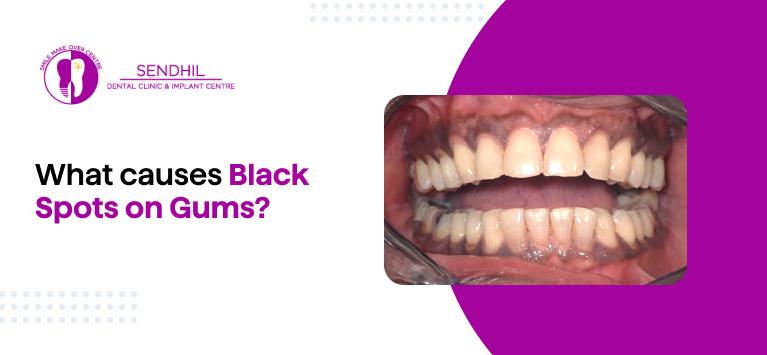
What causes Black Spots on Gums?
Overall, gum health is a crucial aspect of general oral hygiene. One may be naturally concerned while not showing clear signs of an issue, such as black spots on gum tissue. While most people know common problems such as cavities and gum diseases, black marks on their gums are anything but ordinary and can be problematic. You’ll be able to find some peace of mind and ensure you get the right help, knowing precisely the cause of these spots.
Table of Contents
1. Melanin Hyperpigmentation
Melanin hyperpigmentation is one of the most common and harmless reasons behind black spots on gums. Melanin is the standard pigment found in skin, hair, and eyes, which gives them color. In the case of gums, high melanin production can lead to dark patches on gum, especially in those with darker skin. Nothing is pathological about this condition, and it does not involve any health risk. Melanin hyperpigmentation occurs naturally and does not require any treatment.
Symptoms
Dark patches on the gum are usually symmetrical and appear on both sides of the gum. They develop over the years, with fluctuations in hormone levels, for example, during pregnancy and as an effect of some medications. Although the spots above represent a harmless condition, one cannot ignore that visiting a professional dentist is always in place to rule out any hesitation that what you see is true melanin hyper-pigmentation.
2. Amalgam Tattoos
Other common causes of black spots on the gums include amalgam tattoos. These are tiny pieces of dental amalgam used for fillings and can get embedded in the gum tissue during some dental procedures. While not hazardous themselves, amalgam tattoos may be misidentified as other more dangerous conditions and are not treated.
How Does It Happen?
During dental procedures, such as filling a cavity, tiny particles from the amalgam may break away and become embedded in the soft gum tissue. Over time, these particles oxidize, resulting in a black or darkened discoloration. The spot remains where the filling or other dental work was placed and is usually painless.
Should You Be Concerned?
Although the amalgam tattoos are harmless, they are permanent. Although most people do not mind their presence, some may opt for their removal by laser therapy if the appearance proves unsightly; however, one should check with a dentist to confirm if it is an amalgam tattoo and not something more severe in diagnosis.
3. Oral Melanoma
While most black spots on gums are harmless, some severe conditions, including oral melanoma, need to be ruled out. Oral melanoma is an uncommon but very aggressive form of cancer that might appear first as a dark or black spot on the gums or inside cheeks; it may also appear elsewhere in the mouth. In sharp contrast to benign conditions, oral melanoma spreads rapidly and needs to be treated promptly.
Symptoms
These oral melanoma spots can be irregular in shape and color, black, brown, or blue. They may also change in size, bleed, or ulcerate. In contrast to melanin hyperpigmentation or amalgam tattoos, oral melanoma causes discomfort or pain when progressing.
When to Seek Help
If an individual notices some new dark spot over the gums, mainly changes in its look, or some associated symptoms, such as pain, bleeding, and swelling, then it advises the individual to consult with the dentist or oral specialist immediately. Early detection is the key to successful treatment for oral melanoma.
4. Fungal Infections
Other fungal infections, such as thrush, also result in discoloration in the mouth and may cause black marks on gum. Although thrush is characteristically white, other fungal infections may appear as dark spots depending on the pathogen strain and reaction.
How Do Fungal Infections Develop?
The usual cause of the fungal infections in the mouth is the rapid growth of Candida overgrowth, a more typical form of yeast. Weakened immunity, prolonged antibiotic intake, diabetes, and denture-wearing are the possible causes of the onset of fungal infections. Brown spots on the gums may appear occasionally as a result of these infections, particularly if treatment is not received.
Treatment and Prevention
Treatments for fungal infections most often take the form of antifungal drugs taken orally or applied in ointment. Following good oral hygiene practices, avoiding sugar in one’s diet, cleaning dentures regularly, and ensuring appliances fit well can help prevent infection caused by fungi. If you think your black patch on gum might be a fungal infection, seek advice from a professional on how to deal with it.
5. Bruising or Hematomas
Black or dark spots on the gums may also develop due to physical injury to the mouth. It can occur due to accidental biting, because of some dental procedures, or even by strong scrubbing. Trauma might cause the rupture of small blood vessels in the gums and lead to the formation of a bruise or hematoma.
How to Identify Trauma-Induced Spots
A traumatic spot, however, will show up suddenly and can be associated with swelling or tenderness. Unlike the above mentioned black spots, these bruises are known to get better by themselves when the body heals damaged tissue.
When to Seek Help
If it does not fade to white after a bit, or other symptoms like persistent pain accompany it, one should visit a dentist. The continuous irritation of the gums due to a poorly fitted dental appliance or habitual biting is also the cause of chronic problems that seek professional help.
6. Medication Side Effects
Some medications, particularly those involved in blood clotting and immune response, can be associated with discoloration of the gums. Examples include the following:
- Some antimalarial drugs are known to cause changes in pigmentation and, hence, black spots on the gums.
- Antibiotics.
- Some medications are used to treat some autoimmune diseases.
Should You Be Concerned?
If you have some black patch on your gum after taking some new medication, contact your doctor. They will be in an excellent position to tell whether it is the cause and if there should be a treatment change. Though discoloration might often be perfectly harmless, you need to rule out other causes.
7. Oral Hemangiomas
Oral hemangiomas are benign vascular lesions representing an abnormal proliferation of vessels, which can occur anywhere in the mouth, including in the gums. These appear as dark red, purple, or black spots.
How Are They Treated?
Most oral hemangiomas are benign, and treatment is not required unless there is discomfort or bleeding. Surgical excision or laser therapy can be performed in more symptomatic cases or in cases where the lesion is frequently subjected to injury.
Conclusion
These black spots on the gums can be due to anything, ranging from benign pigmentation to severe conditions like oral melanoma. While most causes of such spots are innocuous and need no treatment, alterations inside the oral cavity should be tracked. Regular dental check-ups are essential since they allow early detection if something is wrong. If you find a black spot on your gums, which is new, or any other changes that seem unusual to you in your mouth, it’s always best to consult with a dental professional about it to make sure everything remains okay.




